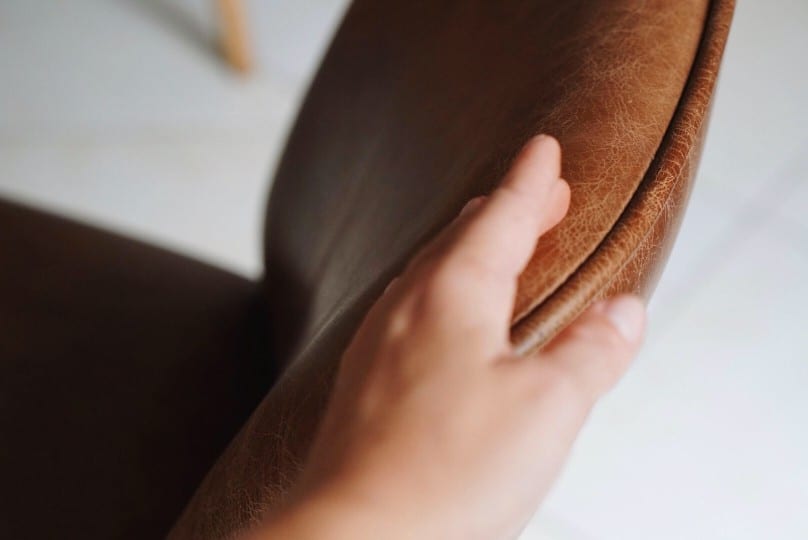Leather. It seems like something so simple, however often times when people shop for furniture, they find out quite the opposite.
There’s genuine leather, faux leather, PU leather, PVC Leather, Vinyl, Bonded Leather… it seems like a never-ending stream of different kinds of leather.
So what do they all mean?
Well, if you share the same leather frustrations as many other furniture shoppers out there, you’re in the right place.
After many reader questions and complaints, our team decided to compile the ultimate leather definition guide.
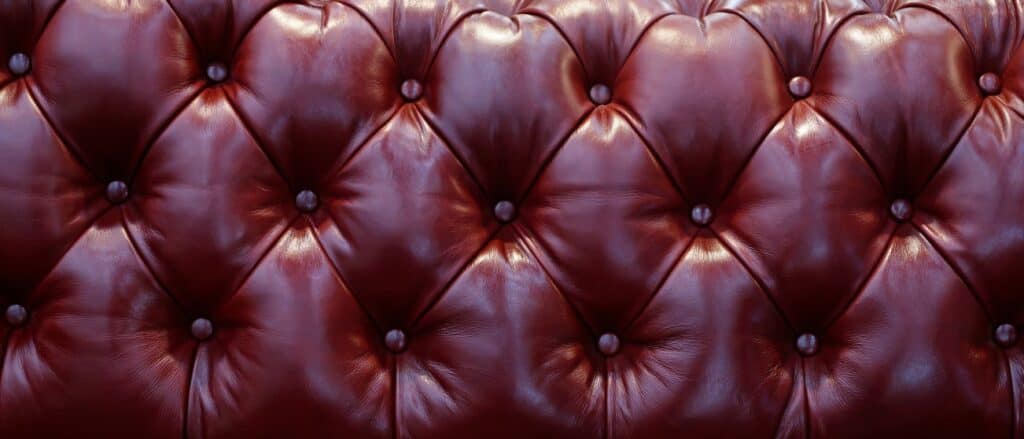
If you’ve ever found yourself asking, “What is PU leather made of? What is Faux Leather? WHY ARE THERE SO MANY KINDS OF LEATHER?!!?”, you came to the right place.
Buying furniture is typically a large ticket item purchase for most people, and it’s important that you pay attention to the type of material used. Now, our blog focuses mainly on office chairs and office furniture.
However, we find that office furniture and pretty much all other types of furniture share the same material diversity when it comes to options.
Even if you’re not in the market for an office chair, this guide is generally applicable to couches, love seats, recliners, etc.
Furthermore, in this guide you learn about the big differences between bonded leather vs genuine leather, PU leather vs bonded leather, etc.
Real Leather: Full Grain, Top Grain and Genuine Defined
The leather industry can have somewhat misleading labels that can add a lot of confusion to a consumer’s purchasing decision.
Luckily, you ended up on our in-depth guide about everything leather and you’re about to learn about the three most commonly used terms to define 100% real leather.
The three main types of leather, ranging from nicest more average, are Full Grain, Top Grain and Genuine.
Keep in mind, all three are 100% real leather and are almost always better than any of the faux or blended leather materials out there. Although genuine is technically the “lower rung” option, it’s still better than, for example, PU leather.
What is Full Grain leather?
Full grain leather is the absolute top-of-the line 100% real leather money can buy. It’s the cream of the crop. When you think of Full grain leather, think of it as the Cadillac of the leather family.
There are many reasons why full grain is the best of breed when it comes to 100% real leather. The reasons include, but aren’t limited to: the way it is made, the way it ages and the way it looks and feels.
Full grain leather is about as real as real leather can get.
Most consumer leather comes from cows, and full grain leather is the entire grain of the hide of the animal.
That means each piece of leather is about as raw as possible because it is processed the least. Full grain is the most durable of all the materials on this list, and it’s also the most expensive.
Each piece of full grain leather is like a fingerprint.
Because of how natural it is, most pieces of this luxurious material show all the imperfections of the animal itself. Furniture made from full grain leather will often look unique; this is yet another reason why this stuff is so pricey.
One of the best aspects of this type of 100% real leather is that it gets better as it ages.
Over time, all the little nuances that come along with the individual animal hide will expose more and more. Coincidentally, it will look more and more unique and stylish as it ages.
Pro’s and Con’s of Full Grain Leather
Pro’s
- Finest grade of 100% real leather money can buy.
- Full grain leather looks better as it ages; all of the subtle nuances are exposed with time.
- Easily the most durable and long-lasting leather materials if cared for properly.
- Highest in style when it comes to the natural leather look.
- Each piece is unique and shows all of the imperfections of the natural animal hide, depending on the processing.
Con’s
- Most expensive leather material; you’re going to dish out a pretty penny for full grain leather.
- Can sometimes show too many imperfections. Make sure you see the product in person before purchasing.
- Requires extensive care over time and constant oiling and conditioning. Full grain leather can turn down a bad path if not properly maintained.
- You won’t get a lot of variation with color and style when it comes to full grain leather. To be called full grain, it essentially has to be the hide straight off the animal; i.e. it cannot be dyed or tampered with much at all. You’re getting brown, basically. That’s it.
Overall Consensus on Going Full Grain
Be wary, some full grain leather can be too imperfect. Although you may come across a good deal on the internet, full grain leather should always be inspected first hand.
Reason being is that pieces of full grain leather vary in look and feel a lot more than other types of leather in this guide; you may come across an advertisement of a nice full grain leather bag, only to find out the pattern and imperfections on the unit you order look totally different from the one you ordered.
What is Top Grain Leather?
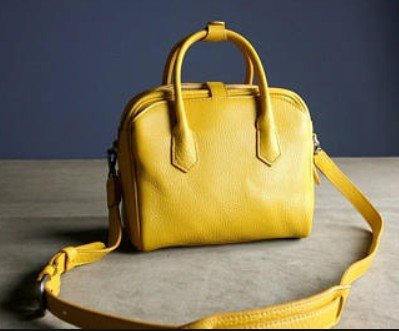
Top grain leather lands at the 2nd best tier when it comes to buying leather products. It falls right in the middle of genuine and full grain leather in so many different ways.
Typically, top grain leather is more widely used than full grain leather for its lack of imperfections.
How is top grain leather made, you ask?
Top grain leather is created by separating the imperfect portion of a full grain hide then sanding it out to be 99.9% uniform with few inconsistencies.
Most high-end wallets and handbags are constructed with top grain leather because of its versatility. It can be dyed in many different colors and won’t look strange because most of the imperfections are removed during the manufacturing process.
Top grain is slightly less durable than full grain leather, however it is still made up of a mostly unaltered animal hide.
Pro’s/Con’s of Full Grain Leather
Pro’s
- Many high-end designer items use top grain leather; overall, it is a luxurious 100% real leather material.
- It’s very versatile and can be dyed. Essentially, top grain leather can come in many different color options without lacking quality.
- Top grain leather is durable and still retains the natural taught-ness of a leather hide.
- Basically, if the product is top grain, you don’t have much to worry about. It’s going to be quality.
Con’s
- Although it’s not as luxurious as full grain leather, most of the time a premium is paid for top grain leather.
- Top grain leather also needs to be regularly maintained and conditioned to retain maximum quality.
- It ages well and lasts a long time with proper care. That being said, top grain leather to not age as well as full grain; it fades over time because all of the natural imperfections and nuances of a raw leather hide are removed during the manufacturing process.
Overall Consensus: Top Grain is Top Shelf
As top grain leather ages, it tends to stay fairly consistent because of how it’s manufactured. What you buy will likely be what you get for years to come with little change when it comes to this material.
It tends to be slightly less expensive than full grain, and much more expensive than genuine leather. Rest assured that if you’re buying a top grain leather item, it has the utmost quality. You should feel more comfortable purchasing this type of leather on the internet without seeing it. That’s because all of the imperfections are removed during processing, and what you see is what you get.
What is Genuine Leather?
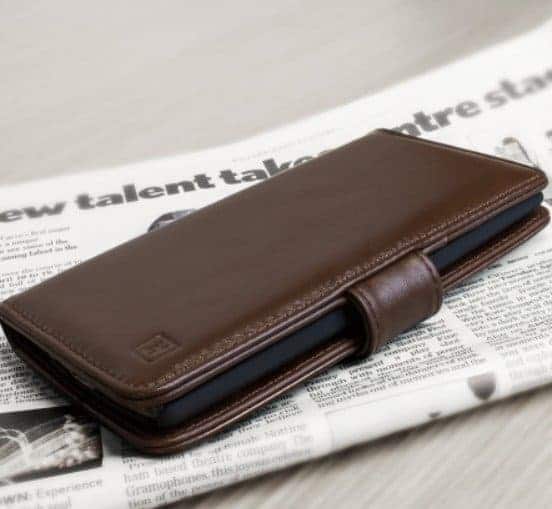
Genuine leather is the lower-end 100% real leather material used to fit different types of furniture. So what is genuine leather?
While it isn’t the highest quality 100% leather material out there, genuine leather is one of the most widely used.
It’s essentially a by-product of full grain and top grain leather. Genuine leather is composed of the scraps of the leather pieces used to make the aforementioned two nicer types of leather.
Basically, genuine leather is made from 100% real leather fibers; that means leather fiber is usually milled down and pressed together to make genuine leather material sheets. Genuine leather is essentially bonded leather made up of 100% real leather.
You’ll understand the bonded leather reference when we get to the faux leather review portion of this guide.
Anyway, genuine leather makes up a lot of 100% leather furniture because of it’s lower cost and formidable quality and durability. When compared to top grain or full grain, genuine leather can sometimes be noticeably less desirable.
The problem with genuine leather is that some of it may be really high quality, while other genuine leather pieces can fall short. This is all due to the nature of how genuine leather is made.
Pro’s and Con’s of Genuine Leather
Pro’s
- Genuine leather is the least expensive of all of the 100% real leather materials, and it has a lot of the same benefits.
- This material has a lot of versatility, so it comes in many different looks and feels. Think color, texture, etc. If you’re shopping for a specific color of leather couch and don’t want to drop a pretty penny, genuine leather could be a good alternative.
- Although it is the lowest quality of 100% real leather, there are still many fine products crafted from genuine leather. However, keep an eye out for poorly constructed genuine leather products.
Con’s
- Genuine leather products can be hit or miss because of how it is constructed; some genuine leather products are nicer than others with the same “made with 100% real genuine leather” advertisement.
- It must be maintained and properly conditioned like all other 100% real leather products to yield maximum lifetime value.
- The somewhat fickle material can be difficult to shop for; if it’s a unique product not made by a major company, make sure you see it in person.
- Be wary of advertising and sales people trying to pitch genuine leather as the “cream of the crop”. Unfortunately, the term “genuine leather” sounds fancy and is often misconstrued to be something of better quality than it actually is.
Overall Thoughts on Genuine Leather Products
Genuine leather is tricky, and it can either be good or bad. Have you ever heard of getting a “lemon” car even though it’s brand new? Some cars right off the lot can be a lemon, while the same exact make model and year of car can be really nice and reliable.
The same thing goes with genuine leather.
Bottom line, the best way to shop for genuine leather is in person, especially if it’s a larger ticket item like a sofa or an office chair.
Be sure to sit in it, feel it and inspect the stitching and look of the furniture. Believe it or not, in some cases we’ve found bonded leather office chairs we would recommend over genuine leather ones.
If you’re shopping at this level of quality, it’s best to see and feel the piece in person.
When it comes to furniture, you’re still going to find that genuine leather is more expensive because it can be marketed as “100% real leather”. Sometimes it’s worth the label, and unfortunately other times you might get a lemon
What is Faux Leather? Bonded leather and PU leather defined
Faux leather is an all-encompassing term that can mean several different things. There are a lot of different types and qualities, and not all fake leather is bad. There is an unfortunate misconception that faux leather is no bueno; however, that isn’t always quite the case.
If you know the right terms and do the right research, finding a quality faux leather office chair, gaming chair or other piece of furniture is entirely doable.
In this section, we will go over everything you need to know about bonded leather and PU leather; those two just so happen to be the most common forms of faux leather.
What is Bonded Leather?
Ever wonder about the difference between bonded leather vs genuine leather? Or bonded leather vs faux leather? You’ll learn everything you need to know right here and right now.
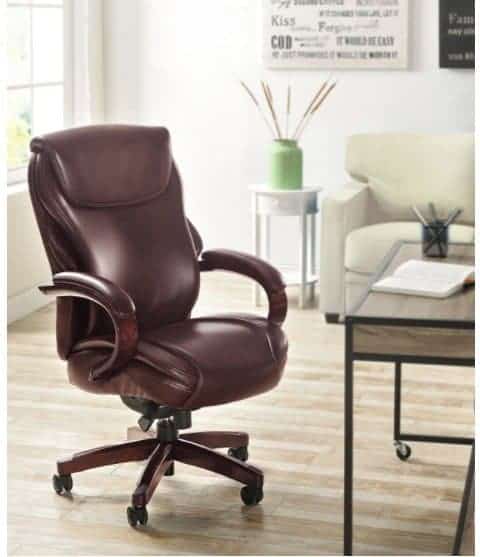
According to the Federal Trade Commission 16 C.F.R. Section 24:
“For example: An industry product made of a composition material consisting of 60% shredded leather fibers may be described as: Bonded Leather Containing 60% Leather Fibers and 40% Non-leather Substances”
The FTC clearly states that bonded leather must be at least 60% leather fibers – so there you go! Now you know exactly what bonded leather is.
Additionally, the FTC has warned and recommended all manufacturers to disclose how much leather fiber is in any product labelled as bonded leather. If you’re curious, read more about the regulations of bonded leather by clicking the link above.
Now that we’ve gotten through the boring part of bonded leather, let’s jump into the quality of the material, what to look out for and if it’s worth purchasing or not.
Like genuine leather, bonded leather can be tricky. Some bonded leather products are noticeably better than others in every single way; this can make it tricky to find good ones.
Similar to what we recommended earlier, the best way to buy anything bonded leather is to see it in person.
Many say cheap bonded leather can smell like chemicals; so if you’re considering a sofa made from this type of material, make sure to smell it!
That’s right – sniff it out before buying it.
If it smells funky or unpleasant, I’d avoid it.
Pro’s and Con’s of Bonded Leather
Pro’s
- Significantly less expensive than 100% real leather materials. Some great bargains live in the world of bonded leather.
- You can find some really nice bonded leathers that are better quality than the “lemon” genuine leather products mentioned earlier.
- While not as durable as the 100% real leather category, bonded leather still retains some of the durability as its superiors.
- All products advertised as bonded leather are at least 60% leather fiber; sometimes it can be more, which typically means the product is better quality.
Con’s
- Because bonded leather is only 60% real leather, there’s inherent risk of poor quality products. Some manufacturers may make better quality bonded leather than others. Remember, always smell bonded leather for a chemical scent.
- Be careful of borderline false advertising. Many people don’t know what bonded leather is, and the material can be contorted to be of better quality than it actually is.
- Bonded leather products can be a good deal, but it’s important to check the quality with a fine eye. This requires a lot more research and in-person inspection.
General Consensus of Bonded Leather Material
Online reviews are another good go-to place when shopping for this material. Make sure you read up on what other people have to say about the bonded leather product before pulling the trigger.
There are plenty of fine bonded leather products out there, and one of the biggest benefits of the material is that it is cheap.
You’ll find a lot of bargain deals made from bonded leather, just make sure to test it out before you buy! Oh, and always inquire what percentage of leather fiber the product is made up of.
Be careful for advertisements like, “cushions made from fine bonded leather”.
That can mean only part of a chair or sofa is made from bonded leather.
The other 40% of bonded leather typically consists of mostly polyurethane with some potential other components. We will cover what polyurethane is in the next section if you’re curious to learn more.
What is PU Leather? The Actual PU Leather Meaning Explained
When most people think of fake leather, they think of 80’s “pleather” pants that look like this:

So the whole synthetic leather material doesn’t have that great of a first impression.
However, do not fret, because 100% fake leather has made a lot of improvements over the years. The “PU” in PU Leather stands for polyurethane.
Polyurethane is ALL around us, and it’s a very common coating in many everyday items. It can be found in everything from car seating, rollerblade wheels and different types of glossy finish paints.
Polyurethane is also a very common component in many furniture pieces, including our favorite: office chairs. It’s also a typically the other 40% component of bonded leather as mentioned in the previous section. It’s typically a durable material, however it’s not quite as high of quality as 100% real leather.
There are many reasons why PU leather, or a mainly polyurethane product would be worth buying. For starters, it’s almost always cheaper than other 100% real leather or bonded leather products.
One thing you should know is that any PU leather or polyurethane product should be the cheaper option; look out for people trying to make it seem like it is better than it actually is.
Rest assured, if a product is advertised as PU leather, it is not as high quality as other products out there.
That being said, there are plenty of PU leather products our team recommends first hand. We are in the business of office chairs, and there are plenty of office chairs out there that are really nice and fitted with 100% PU leather.
If you’re shopping for furniture and considering PU leather, here’s what to consider:
- As mentioned in the bonded leather section: SMELL IT! Yes, smell it. Some PU leather can STINK and it lingers for a long time.
- Make sure it has breathable components like an airflow system – PU leather is the least breathable leather composite material.
- Check the stitching and make sure it looks well done.
- PU leather can have a surface coat; ask about this, because lower quality polyurethane coating can flake off over time.
Pro’s and Con’s of PU Leather
Pro’s
- One of the cheapest (fake) leather products available; if you’re shopping with a hairline budget, you may want to start with PU leather.
- Animal friendly material; it’s 100% synthetic, so if you’re conscious about animal welfare, 100% PU leather is a good option; however, make sure it’s 100% PU leather, because other labels can contain animal products.
- PU leather comes in a lot of different variations meaning style, color, etc. because of its versatility.
- Polyurethane products have come a long way over the past years and the overall quality of the material has gotten better.
- Easy to maintain and doesn’t need the intense conditioning as 100% real leather.
Con’s
- PU leather doesn’t age well and tends to wear and tear faster than real leather products.
- Watch out for bad-smelling material – often times that smells is difficult to get rid of.
- Some PU leather materials are better than others, so finding a nice piece made from this material can be a toss-up.
- Can be noticeably fake looking when compared to 100% real leather depending on the item.
- Furniture made from PU leather can lack breathability
Overall Thoughts on PU Leather
Overall, it’s not that bad of a material and PU leather is definitely the least expensive of the bunch. PU leather products typically have a shorter lifetime value when compared to bonded, genuine, top grain and full grain leathers. That being said, you can get a heck of a discount if you find a diamond in the rough piece constructed with bonded leather.
How to choose the right material
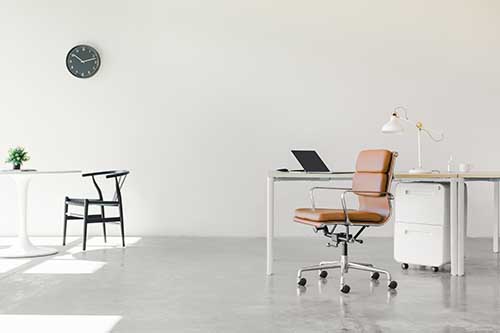
There are several decision criteria to consider when purchasing an office chair, or any piece of furniture for that matter. See below for some general guidelines regarding all of the above covered materials.
Price and Budget
- Full Grain Leather: High-range budget
- Top Grain Leather: Mid to High-range budget
- Genuine Leather: Mid range Budget
- Bonded Leather: Mid-range to the lower end of the budget
- PU Leather: Low-end budget
- Faux Leather: Can be bonded, typically faux leather labels are cheaper
- MicroFiber: Varies; some are much nicer than others. Hence you get a wide range of prices in this category.
Quality
- Full Grain Leather: Highest level of quality
- Top Grain Leather: Excellent quality
- Genuine Leather: Satisfactory to excellent quality; it can range because of the nature of the manufacturing process
- Bonded Leather: Average to Satisfactory quality
- PU Leather: Average quality to lower tier quality
- Faux Leather: Average to low-end quality
- MicroFiber: Average to Satisfactory quality
Durability
- Full Grain Leather: Max-durability that gets better as it ages
- Top Grain Leather: Long lasting and top rated durability
- Genuine Leather: Durability can vary due to the nature of the material; not all genuine leather is made the same.
- Bonded Leather: Average to Satisfactory quality
- PU Leather: Average quality to lower tier quality
- Faux Leather: Average to low-end quality
- MicroFiber: Average to Satisfactory quality
Lifetime Value
- Full Grain Leather: Best lifetime value; gets better with age like a fine whiskey.
- Top Grain Leather: Great lifetime value – will last longer than most other materials.
- Genuine Leather: Lifetime value can be up there, however it varies.
- Bonded Leather: Lifetime value not quite the same as genuine leather, you get less of a chance of finding a great bonded leather piece of furniture.
- PU Leather: Average lifetime value, more prone to tearing but easier to maintain
- Faux Leather: It’s a toss-up – some are better than others. If this is the only label, it’s unsure what you’re actually buying.
- MicroFiber: Depends – if it’s a nice mesh, it can last a long time. Safest bet is to go with a brand you trust if purchasing microfiber.
